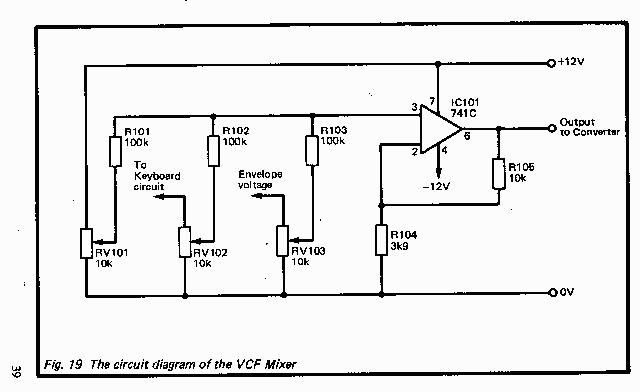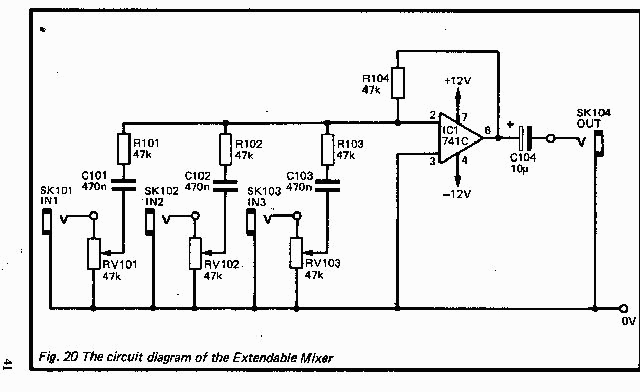<<- Back ^- Intro -^ Forward ->>
Chapter 2: Mixers
Mixers
VCF Mixer
The modules described so far are the main building blocks of a synthesiser, but a practical instrument usually has some additional circuits. Just what additional circuits are required depends on the way in which the main modules are to be interconnected and used, and on how many of these modules the instrument is to incorporate. Anyway, the circuits described in the following section of this book should prove useful in getting the most out of the instrument and in extending its capabilities.
As mentioned in Chapter 1, in order to get the most from the VCF it should be driven from three voltage sources, the keyboard, an envelope shaper, and a manually controllable voltage. In order to do this a suitable mixer circuit is required, and such a design is shown in Figure 19.
Although the circuit incorporates an operational amplifier it is not the usual summing mode type of mixer circuit. Ibis type of mixer is unsuitable in this case as it provides an unwanted inversion of the signal. This circuit is really a passive mixer using R101, R102, and R103, followed by a non-inverting amplifier which compensates for the losses through the passive mixer. RV101 to RV103 enable the contributions from the three voltage sources to be mixed in the desired proportions. Note that this circuit must drive the VCF via the logarithmic current source, and that it should not be used to drive it directly.
DC Mixer Components (Fig. 19)
Resistors (all 1/4 watt 5%) R 101, 102,103 100k R104 3k9 R105 10k Potentiometers RV101,102,103 10k Lin Semiconductors IC101 741C Miscellaneous Circuit board Three control knobs Wire, solder, etc.
Extendible Mixer
With a simple, single VCO synthesiser there is only one audio output signal, but with a de ' sign that incorporates two or more VC0s, plus perhaps a noise source as well, there will be several audio signals which must be mixed together to give a single audio output. All that is needed is a basic summing mode mixer such as the design shown in the circuit diagram of Figure 20. As shown in Figure 20 the mixer has three inputs, but if only two are required it is merely necessary to omit RVI03, C103, and R103. If more inputs are required this can easily be achieved. Just add an extra input resistor, DC blocking capacitor, and level potentiometer for each additional channel. In theory any number of extra channels can be added to the circuit, but in practice problems with noise pick up might be experienced if a large number are used. In the present application no more than about five inputs should be needed though, and this number should certainly not result in any problems.
Extendible Mixer Components (Fig. 20)
Resistors (all 1/4 watt 5%) R101,102,103,104 47k Potentiometers RV101,102,103 47k log Capacitors C101,102,103 470nF miniature polyester C104 10uF radial electrolytic Semiconductors icioi 74IC Miscellaneous Circuit board Three control knobs 8 pin DIL IC holder, wire etc.

